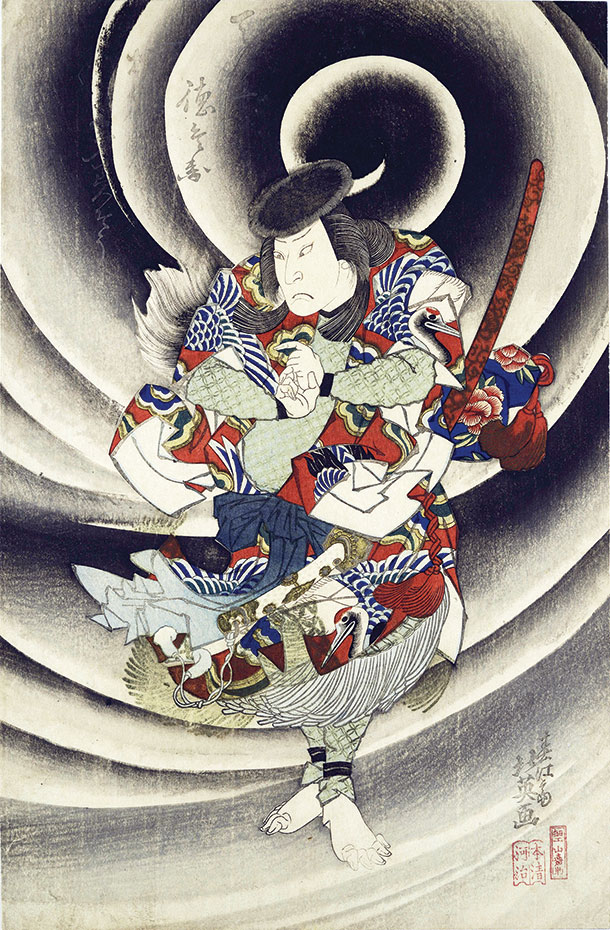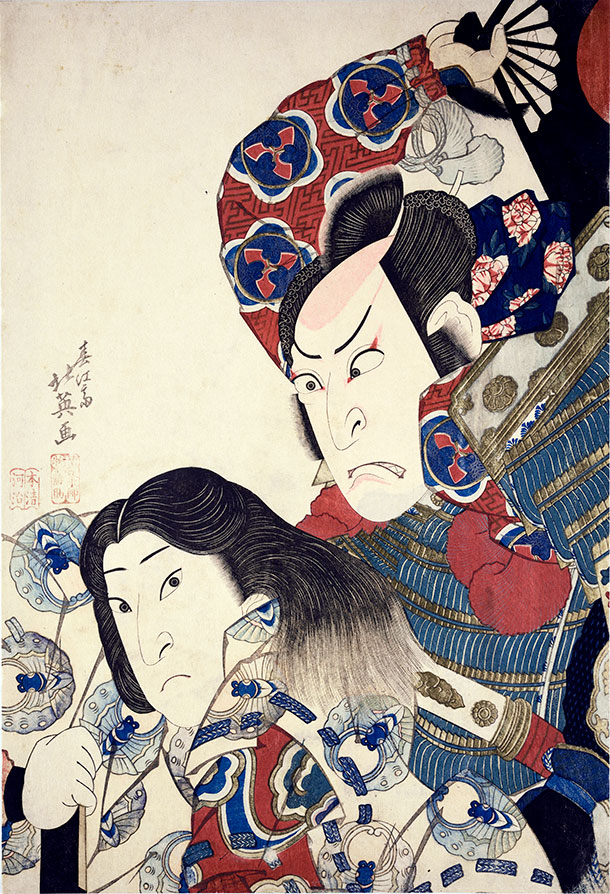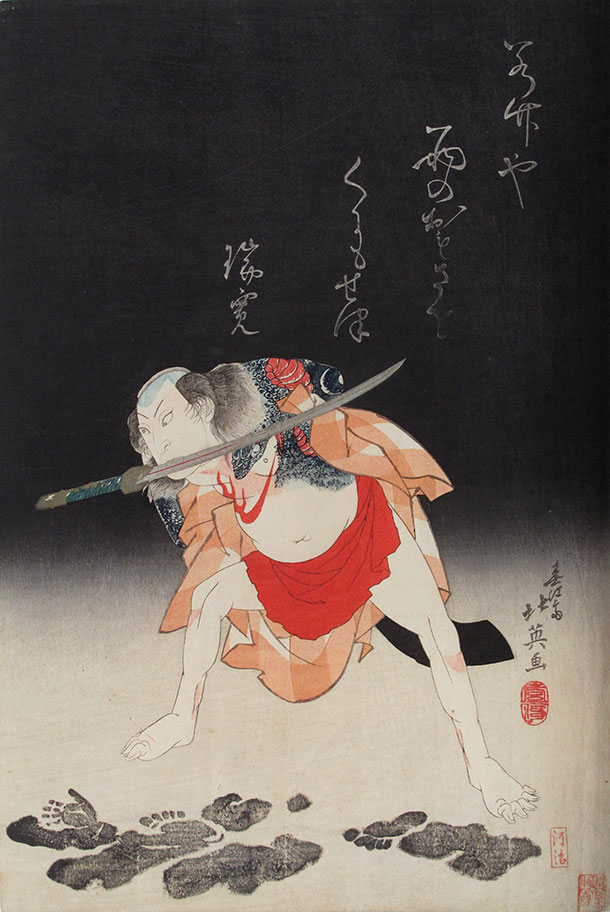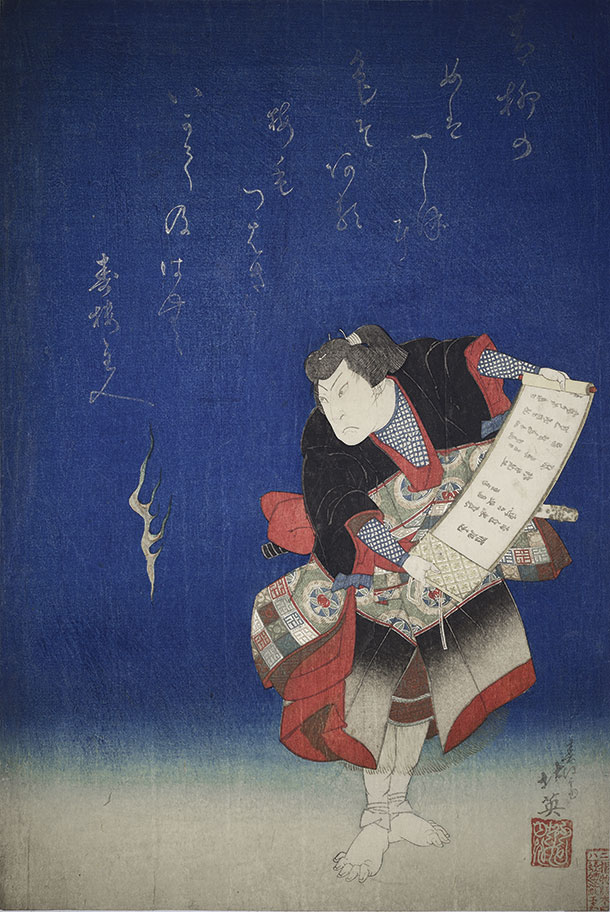

Shunbaisai Hokuei (春梅齋北英)Shunbaisai Hokuei (春梅齋北英), active 1/1828 to c. 8/1836, was the culminating print designer in Osaka's central artistic lineage, whose predecessors were Ryûkôsai, Shôkôsai, and Hokushû. Working for only nine years, Hokuei nevertheless dominated the production of actor prints, especially during the years 1832-36, when he accounted for roughly 60 percent of all prints published in Osaka. Hokuei died in the eleventh lunar month of 1836.
Many of Hokuei's prints were technical marvels employing advanced block-cutting and printing techniques. He often used a tension-filled dramatic approach toward much of his actor portraiture, sometimes positioning isolated figures against monochromatic backgrounds to emphasize the actors' expressions and emotional states. He experimented with unusual placements of solitary figures, which when combined with articulated gestures, postures, and facial expressions (mie, or "display": 見得), resulted in a notable body of work. Hokuei also arranged solitary figures to suggest related action beyond the confines of the single sheet, which added a sense of uncertainty and dramatic possibility that tempted the viewer to fill in the missing narrative. Hokuei's first masterpiece (shown above), signed with his earlier gô (號) or art name Shunkôsai (春江齋), portrays Onoe Tamizô II (尾上多見蔵) as Chigo Takimaru (児滝丸) in the play Keisei harimameguri (possibly meaning "A courtesan's turn for improvement": けいせい播磨廻) at the Onishi Theater, Osaka in 1/1830. Co-published by Honsei (本清) and Kawaji (河治), the deluxe design in ôban format, shown at the right, was Hokuei's first collaboration with the gifted block carver Yama Kasuke (山嘉助) who had produced works for, and been a student of, Hokuei's teacher Shunkôsai Hokushû. (On this print, Kasuke applied a hand-stamped seal at the lower right reading saiku Yama Kasuke, work of Yama Kasuke; 細工山嘉助.) The actor Tamizô, wearing a fabulous robe decorated with cranes, stands within a whirlwind he has conjured as his robes whip about in the vortex. Using magical powers to control the elements of nature, he positions his hands in a sorcerer’s gesture.
Hokuei's first ôkubi-e ("large-head picture: 大首絵) was published early in the first year of his most productive period. This was a deluxe double portrait (see immediately above) featuring Nakamura Utaemon III (中村歌右衛門) as Kumagai no Jirô Naozane (熊谷次郎直実] and Arashi Rikan II (嵐璃寛) as [Taira no Atsumori 平敦盛] in Suma no miyako genpei tsutsuji (Azelea of the Minamoto and Taira from the capital to Suma Bay: 須磨都源平躑躅) at the Kado Theater, Osaka in 2/1832 (see image at left). The play was an adaptation of tales about the Genpei wars (1156–85), the pivotal struggle between the Minamoto (Genji) and Taira (Heike) clans. In kabuki, Kumagai no Jirō Naozane, a general serving Minamoto no Yoshitsune, reluctantly faces in battle the fifteen-year-old Taira no Atsumori. Hokuei’s print was issued for the premiere of the "Gojô Bridge scene," newly written for a revival of Suma no miyako. The episode was, in part, an analogue or parody of a celebrated encounter on Kyoto’s Gojô Bridge between the general Yoshitsune (Ushiwakamaru) and the warrior priest Benkei, often retold in literature and theater. In the 2/1832 play, Atsumori disguises himself as a woman named Kohagi, hiding with the fan-seller Kazusa and his daughter Katsurako. As Atsumori is about to be captured by the Minamoto, Kumagai happens to visit the shop and, owing a debt to Atsumori’s mother, protects him by ordering Kazusa to sacrifice Katsurako. Kumagai then presents her head to the Minamoto in place of Atsumori's. In the scene presented in Hokuei's print, Atsumori prays for Katsurako’s soul at the Gojô Bridge, and then gives a war-fan (gunsen: 軍扇) to Kumagai, promising to meet him on the battlefield at Ichinotani. Published by Honsei (本清) and Kawaji (河治), the blocks were carved by the eminent surimono hangishi Kasuke (Kasuke, surimono woodblock master: 摺物版木師嘉助), whose seal is hand-stamped below Hokuei's signature. This masterpiece of Osaka printmaking relies on a dramatic contrast between the formidable Kumagai towering over his over-matched but resolute teenaged foe. The image shown immediately below is a deluxe print in ôban format depicting Arashi Rikan II (嵐璃寛) as Danshichi Kurobei (団七九郎兵衛) in the play Natsu matsuri Naniwa kagami (Mirror of the Naniwa Summer Festival: 夏祭浪花鑑), first produced for the puppet theater in 7/1745 and in the next month for kabuki. It portrays, with chilling effectiveness, one of kabuki's most gruesome and exciting moments, the famous "back-street murder scene." Hokuei's design, issued for a performance at the Onishi Theater, Osaka in 5/1832, again bears the red hand-stamped seals of the publisher Kawaji and the master block carver Kasuke.
Danshichi was an otokodate ("standing fellow" or "chivalrous commoner," a defender of the downtrodden) who had been imprisoned for wounding a retainer named Sagaemon. Paroled on the condition that he renounce violence, he was forced to confront his wicked father-in-law, Giheiji, who was attempting to kidnap a fugitive courtesan named Kotoura and sell her to Sagaemon. Sworn to protect her because she is the lover of a friend, Danshichi offers to buy her freedom, but he cannot produce immediate payment. Giheiji taunts him mercilessly, and although Danshichi attempts to control his anger, he finally becomes enraged beyond endurance and struggles with Giheiji, slashing him with his sword. As his father-in-law screams "murderer!," Danshichi finishes him off with a thrust through the heart and then escapes by blending into a nearby festival procession. There is a poem written in metallic pigment against the black night sky composed by the actor Rikan. It uses a conventional image of bamboo bending but not breaking as an intentionally ironic metaphor for the explosive Danshichi whose rage cracked his resolve. It translates as, "The young bamboo / is not burdened / by the heavy rain" (Wakadake ya / me no omotai / kunimo sezu: 若竹や雨のおもさをくにもせつ). The murder scene was a favorite with kabuki audiences who found the actor's movements thrilling and eerily beautiful. Some productions feature a virtuoso sequence of poses, numbering as many as thirteen "murderer’s displays" (koroshi no mie). Rikan is dressed only in a red loin cloth while exhibiting a vividly tattooed upper torso (actually, a painted or patterned costume in kabuki). Hokuei's print captures Danshichi in his rage as he poses against the sepulchral night. While Giheiji crawls away, Danshichi strikes a remarkable mie with his sword held in his clenched teeth as he crouches above Giheiji's muddy prints. In stalking Giheiji, we might imagine that Danshichi is confronting a personal darkness. As he looks past the left edge of the sheet, the viewer who is familiar with the scene could visualize the pitiable and frightful figure of the dying Giheiji. This is a composition stripped down to its essentials, and it is Hokuei's most dramatic use of the isolated figure gesturing beyond the edge of a composition. Rarely has violence been portrayed with such penetrating psychological insight in ukiyo-e prints, and this composition is a highlight of dramatic single-figure portraiture in the Osaka school and, indeed, in all ukiyo-e.
A remarkable full-length actor portrait appeared late in the first year of his most active period (see immedaitely above). The deluxe ôban depicts Arashi Rikan II (嵐璃寛) as [shogun] Taira Tarô Yoshikado (平太郎良門) in Sôma Tarô mibae bundan (The Story of Tarô, Heir to the Sôma Clan: 染馬太郞莩文談) at the Naka Theater, Osaka in 11/1832. There is no publisher seal, but an artist seal reads Fumoto no yuki (snow in the foothills: ふもとのゆき) and the block carver seal translates as Naniwa surimono hangishi Kasuke (Kasuke, surimono woodblock master of Osaka: ナニハ摺物版木師嘉助). As with many standard surimono (privately issued prints), there is a poem, in this instance a verse comparing the merits of a actor's performance with the beauties of nature: Aoyagi no me / wa hitoshio ni / iro zo aru / ume mo tsubaki mo / ikade oyoban (The young buds of the willow / are so colorful, / how could the plum / and camellia / ever equal them?) 青柳のめそ一しほに色そある梅もつはきもいかて及はむ), which is signed "Jubai Shujin" (寿梅主人). This performance was on the program for a kaomise ("face-showing": 顔見世) — the introduction of newly engaged actors for the upcoming theatrical season. The story combines elements of history and legend set in the tenth century when the ambitious Taira no Masakado (Sôma no Kojirô, died 940), a general formerly with the regent Fujiwara Takahira, maneuvered to take control of the eight eastern provinces and declare himself emperor. Takahira’s warriors defeated Masakado and then his son Sôma Tarô (the shogun Taira Tarô Yoshikado) during a failed attempt to avenge his father's death. Hokuei portrays Sôma Tarô opening a scroll inscribed with magical incantations, which he hopes to use against the Fujiwara clan. Here, he spies his father Masakado's shinka (spirit fire: 神火) flickering in the air. The carving by Kasuke and printing of this design have long secured its place among the best examples in Osaka printmaking. The shade of cobalt blue used for the background is exceedingly rare in Kamigata printmaking. © 1999-2021 by John Fiorillo For other prints by Hokuei, see Hayagawari and Surimono/Deluxe. BIBLIOGRAPHY
|
Viewing Japanese Prints |



